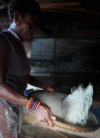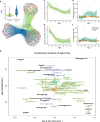The making of the oral microbiome in Agta hunter-gatherers
- PMID: 37587941
- PMCID: PMC10426117
- DOI: 10.1017/ehs.2023.9
The making of the oral microbiome in Agta hunter-gatherers
Abstract
Ecological and genetic factors have influenced the composition of the human microbiome during our evolutionary history. We analysed the oral microbiota of the Agta, a hunter-gatherer population where some members have adopted an agricultural diet. We show that age is the strongest factor modulating the microbiome, probably through immunosenescence since we identified an increase in the number of species classified as pathogens with age. We also characterised biological and cultural processes generating sexual dimorphism in the oral microbiome. A small subset of oral bacteria is influenced by the host genome, linking host collagen genes to bacterial biofilm formation. Our data also suggest that shifting from a fish/meat diet to a rice-rich diet transforms their microbiome, mirroring the Neolithic transition. All of these factors have implications in the epidemiology of oral diseases. Thus, the human oral microbiome is multifactorial and shaped by various ecological and social factors that modify the oral environment.
Keywords: Neolithic transition; hunter–gatherers; oral microbiome; pathogen transmission.
© The Author(s) 2023.
Conflict of interest statement
The authors declare none.
Figures




Similar articles
-
Agta hunter-gatherer oral microbiomes are shaped by contact network structure.Evol Hum Sci. 2023 Feb 23;5:e9. doi: 10.1017/ehs.2023.4. eCollection 2023. Evol Hum Sci. 2023. PMID: 37587930 Free PMC article.
-
Ancient oral microbiomes support gradual Neolithic dietary shifts towards agriculture.Nat Commun. 2022 Nov 22;13(1):6927. doi: 10.1038/s41467-022-34416-0. Nat Commun. 2022. PMID: 36414613 Free PMC article.
-
Oral microbiomes from hunter-gatherers and traditional farmers reveal shifts in commensal balance and pathogen load linked to diet.Mol Ecol. 2018 Jan;27(1):182-195. doi: 10.1111/mec.14435. Epub 2017 Dec 14. Mol Ecol. 2018. PMID: 29165844
-
Geography, Ethnicity or Subsistence-Specific Variations in Human Microbiome Composition and Diversity.Front Microbiol. 2017 Jun 23;8:1162. doi: 10.3389/fmicb.2017.01162. eCollection 2017. Front Microbiol. 2017. PMID: 28690602 Free PMC article. Review.
-
Reconstructing prehistoric demography: What role for extant hunter-gatherers?Evol Anthropol. 2020 Nov;29(6):332-345. doi: 10.1002/evan.21869. Epub 2020 Oct 26. Evol Anthropol. 2020. PMID: 33103830 Review.
Cited by
-
Nepali oral microbiomes reflect a gradient of lifestyles from traditional to industrialized.Microbiome. 2024 Nov 4;12(1):228. doi: 10.1186/s40168-024-01941-7. Microbiome. 2024. PMID: 39497165 Free PMC article.
-
Agta hunter-gatherer oral microbiomes are shaped by contact network structure.Evol Hum Sci. 2023 Feb 23;5:e9. doi: 10.1017/ehs.2023.4. eCollection 2023. Evol Hum Sci. 2023. PMID: 37587930 Free PMC article.
-
Hunter-gatherer genetics research: Importance and avenues.Evol Hum Sci. 2024 Feb 15;6:e15. doi: 10.1017/ehs.2024.7. eCollection 2024. Evol Hum Sci. 2024. PMID: 38516374 Free PMC article.
-
From wolves to humans: oral microbiome resistance to transfer across mammalian hosts.mBio. 2024 Mar 13;15(3):e0334223. doi: 10.1128/mbio.03342-23. Epub 2024 Feb 1. mBio. 2024. PMID: 38299854 Free PMC article.
References
-
- Adler, C. J., Dobney, K., Weyrich, L. S., Kaidonis, J., Walker, A. W., Haak, W., … Cooper, A. (2013). Sequencing ancient calcified dental plaque shows changes in oral microbiota with dietary shifts of the Neolithic and Industrial revolutions. Nature Genetics, 45(4), 450–455. 10.1038/ng.2536 - DOI - PMC - PubMed
-
- Alexa, A. & Rahnenfuhrer, J. (2019). topGO: Enrichment Analysis for Gene Ontology. R package version 2.52.0.
-
- Bellussi, L., Passali, F. M., Ralli, M., De Vincentiis, M., Greco, A. V., & Passali, D. (2019). An overview on upper respiratory tract infections and bacteriotherapy as innovative therapeutic strategy. European Reviews on Medical and Pharmacological Science, 23, 27–38. 10.26355/eurrev_201903_17345 - DOI - PubMed
LinkOut - more resources
Full Text Sources
